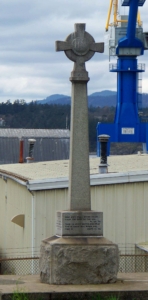THE WARSPITE MONUMENT – History
The Warspite Monument was erected sometime between July 26, 1891 and the end of 1894. This monument consists of a four metre high Celtic cross made of an unusual type of granite not native to Canada. Because of this, historians believe it was made in England and shipped to Esquimalt. It is situated near the site of the Skinner’s Cove passenger landing and would have been one of the first things someone arriving at Naden by ship would have seen. It appears as a reference point on many early maps of Esquimalt harbour.
The monument was erected by the parents of four midshipmen from HMS WARSPITE. The four are believed to have drowned in a canoe accident off Albert Head. Their names – Ralph Caldwell, Honourable A. Alberic De Montmorency, Percival A. H. Brown and Douglas C. Johnstone – are listed on the monument in order of academic ranking from HMS Britannia, a training establishment at Dartmouth which they all attended prior to receiving their first appointment to an RN ship.
On July 5, 1891, HMS WARSPITE arrived in Esquimalt for repairs of structural faults resulting from war action in Chile. De Montmorency, Johnstone and Caldwell had been here with HMS WARSPITE on her former visit; Midshipman Brown joined the ship at Panama. On Thursday July 9, 1891 half the crew were given leave.
Our four midshipmen probably began their shore leave on the 9th or 10th of July. They set off in two canoes purchased from the local First Nations people by Midshipman De Montmorency, and weren’t expected back until Friday July 18th. They had planned to enjoy a few days camping at Pedder Bay, near where the Rocky Point Ammunition Deport is now situated. Their instructions were not to go beyond Race Rocks, on account of the treacherous currents. When they failed to return on Friday, a steam launch was sent for them. It came back with the news that the residents of Manor Farm, near Pedder Bay, had said that the midshipmen had left for Esquimalt on Wednesday July 15.
One of the canoes was found floating bottom upwards off Beacon Hill, on that same Wednesday, by a fisherman. The second was found abandoned at Albert Head with a tin cup and a paddle tied under the seat, mast up, and sail hanging in the water. A pocket knife was also found. On Wednesday July 22, Admiral Hotham wired London that the young men had been lost. The first of four obituaries to these midshipmen appeared in ‘The Times’ in London on Saturday, July 25. The Warspite Monument is not the only memorial to these midshipmen. There is also a plaque to their memory in the nave of St. Ann’s Chapel in Portsmouth. It was placed there by the officers of HMS WARSPITE.
The Warspite memorial, which could formerly be reached from the Naden side of CFB Esquimalt, is now on the grounds of the Esquimalt Graving Dock property and is not accessible to the public, due to a change in the configuration of fencing and property lines.
by Clare Sharpe
Museum staff member/webmaster

 CFB Esquimalt Naval and Military Museum
CFB Esquimalt Naval and Military Museum CFB Esquimalt Naval and Military Museum
CFB Esquimalt Naval and Military Museum